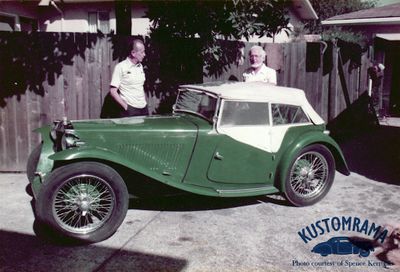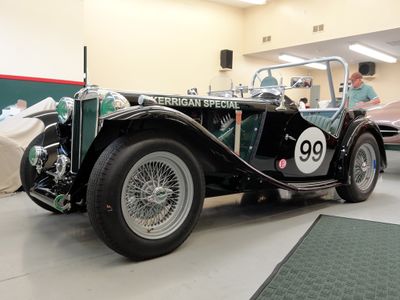Spence Kerrigan's 1949 MG-TC




1949 MG-TC owned by Spence Kerrigan of Oakland, California. Bill Carash helped Spence install a Ford V-8 60 in the MG.[1]
Spence has written a story on his time with the MG that we will reproduce here:
While living in Oakland, California I bought an almost new 1949 MG-TC whose original owner was killed in an automobile accident. The car was gutless so I modified it to stage 2. That modification included reducing the cylinder head thickness by 1/8 inch, installing larger valves, polishing the fuel intake system, and replacing the muffler and tail pipe with a 2 inch diameter straight pipe. I entered it as number 99 in the first Pebble Beach Road Race at Carmel, California. Part of the Pebble Beach track was dirt. So I welded the differential spider gears to lock up the rear end. Cars handle much better in dirt when both rear tires have traction.
My friend Bill Carash and I towed the car on a trailer about half way to Monterey (reminds me of a song I wrote) when the clutch on his Plymouth failed. We spent the night making repairs at his friend's nearby home and reached the track the following day. Race officials informed me that I was disqualified because I missed the previous day's practice session for drivers.
My brother Bill had entered his 1949 MG-TC in the race also. He had done more extensive tuning to his engine, removed the front fenders and installed 16 inch wire wheels. When he learned about my predicament he asked his friend Jay Chamberlain to drive my car. Jay had successfully raced speedboats and midget autos. He may have been the most experienced driver in the first Pebble Beach road race. Why the officials allowed a former professional driver in this amateur race I'll never know.
The race was a LeMans start. My car was about midway in the line up. Jay ran fast and got into the car quickly. Unfortunately, he had trouble shifting into first gear. He was dead last across the starting line. When he came around on the first lap he was up with the leaders. . . forth I believe. Jay had the advantage of his skills plus the locked rear end on the dirt portion of the track. He pulled into the pits on the next lap. The engine was noisy. It had swallowed a valve. Seems Perter Satori's shop in Berkeley, where I had the head work done, sent the head out to a second class machine shop. The head was cut 1/8 inch at one end but almost twice that much at the other end. This caused one valve to beat against a piston or the block 'til it broke. Phil Hill finished first over all in a Jaguar XK120. Brother Bill's number 9 car was right behind Hill's. Bill was second over all and first in the 1500cc class. I believe Jay would have cleaned their clocks had number 99's engine held together.
After he met my lawyer Satori furnished a new head and other parts. He very generously let me do the repair work to my car in his shop. . . using my tools.
My racing ambitions soon ended. I was recalled to participate in the Korean fiasco. I drove the MG to Portland, Oregon to report for duty but within a few days I was transferred to Long Beach, California. I frequently drove between Long Beach and Beverly Hills to visit with my brother Bill who managed the service shop of Peter Satori's Beverly hills dealership and to hang with the sports car buffs at Ernie McAfee's. Ernie was employed as an engineer somewhere locally and owned a speed shop located in a former drive in restaurant in Los Angeles. The late Jack McAfee (no relation) was Ernie's shop manager. Bill and Ernie bored the cylinders of Bill's engine eliminating most of the water jacket and then installed liners to increase the displacement to 1500cc. Bill won many races in Southern California after these modification and after he installed my welded spider gears.
I spent a few months in Southern California before I was transferred to Hamilton Air Force Base north of San Francisco. It was closer to home. Before heading north I bought a 1500cc sleeve and piston set from Ernie. I had the kit installed by Bill Weldon. He had a well equipped machine shop in his back yard in Berkeley where he made rare car parts which were unavailable from the manufacture. He had a regular job at the Besler Corporation in Emeryville.
One of the sleeves in brother Bill's engine had moved downward about 1/16th of an inch. Ernie suggested my sleeves be pressed in tighter. Weldon warned me about too much interference when pressing in the sleeves. I chose to follow Ernie's advice. That was a big mistake. After a few quick miles the block split between the cylinders like a watermelon. Weldon had some pre-stressed bolts made which we installed between the cylinders to squeeze the block together. That worked fine . . . for a while. The car was quick. It stayed ahead of a Jaguar XK120 from a stop sign 'til about 70 mph. That's when a cop stopped us. The Jag driver exclaimed in a British accent: "I say, that car must be tuned!" In addition to the overbore I had built a new intake manifold and installed two Stromberg 97 carburetors with adjustable jets. Stock MGs don't accelerate too quickly because Solar carburetors don't have accelerator pumps. The 97's were a much needed improvement.
When I thought I had all the engine problems solved the metal on top of the block between the cylinders caved in. There was not enough metal left of the original cylinder to support the load imposed when torquing the head. Weldon was allowed to use the Besler factory after hours. That shop had a vapor tank for degreasing which we used to clean the block. Weldon then used special nickel welding rod in an attempt to repair the block. I sealed off all the opening and hydrotested the block. It leaked like a sieve. At that time I was employed by United Centrifugal Pumps in Oakland where one of the welders volunteered to help. I brought the block to the pump shop. The welder soon left the company and the block disappeared. I've since learned how to properly sleeve an engine.
The car sat idle for several months until Bill Carash found a basket of 1937 Ford V/8 Sixty parts. He helped me rebuild and install it in the TC. Bill had built a roadster around a 16 cylinder Cadillac engine. His car won first prize for originality in the first Oakland Roadster Show. It was on the cover of Mechanix Illustrated magazine.
Unlike other MGs with V/8 -60's our conversion did not alter the cowl or the car's external appearance. After cutting the transmission from the Ford flywheel housing and machining the housing to fit the MG transmission we bolted the assembly to the MG block. Carash said it would even sound like an MG if a chain was wrapped around the crankshaft pulley.
We proved the conversion worked but I decided to make the MG look pretty. I removed the car's body, disassembled most everything and painted the pieces. Before I finished assembling my employer transferred me out of state. The MG has been shipped from California to Texas to California then back to Texas. Brother Bill helped get it running in the 1980's but the restoration has been stalled since. The picture in the Roars ad is what it looks like today. A fellow in Pittsburg wants to buy it. By the time ya'll read this it my have found a better home.
Spence sold the MG to Bob Koons who restored the car and built it up for vintage auto racing. During the build up, Bob replaced the Ford engine by a modified MG engine with more displacement than the original.[1]
References
Did you enjoy this article?
Kustomrama is an encyclopedia dedicated to preserve, share and protect traditional hot rod and custom car history from all over the world.
- Help us keep history alive. For as little as 2.99 USD a month you can become a monthly supporter. Click here to learn more.
- Subscribe to our free newsletter and receive regular updates and stories from Kustomrama.
- Do you know someone who would enjoy this article? Click here to forward it.
Can you help us make this article better?
Please get in touch with us at mail@kustomrama.com if you have additional information or photos to share about Spence Kerrigan's 1949 MG-TC.
This article was made possible by:
SunTec Auto Glass - Auto Glass Services on Vintage and Classic Cars
Finding a replacement windshield, back or side glass can be a difficult task when restoring your vintage or custom classic car. It doesn't have to be though now with auto glass specialist companies like www.suntecautoglass.com. They can source OEM or OEM-equivalent glass for older makes/models; which will ensure a proper fit every time. Check them out for more details!
Do you want to see your company here? Click here for more info about how you can advertise your business on Kustomrama.





